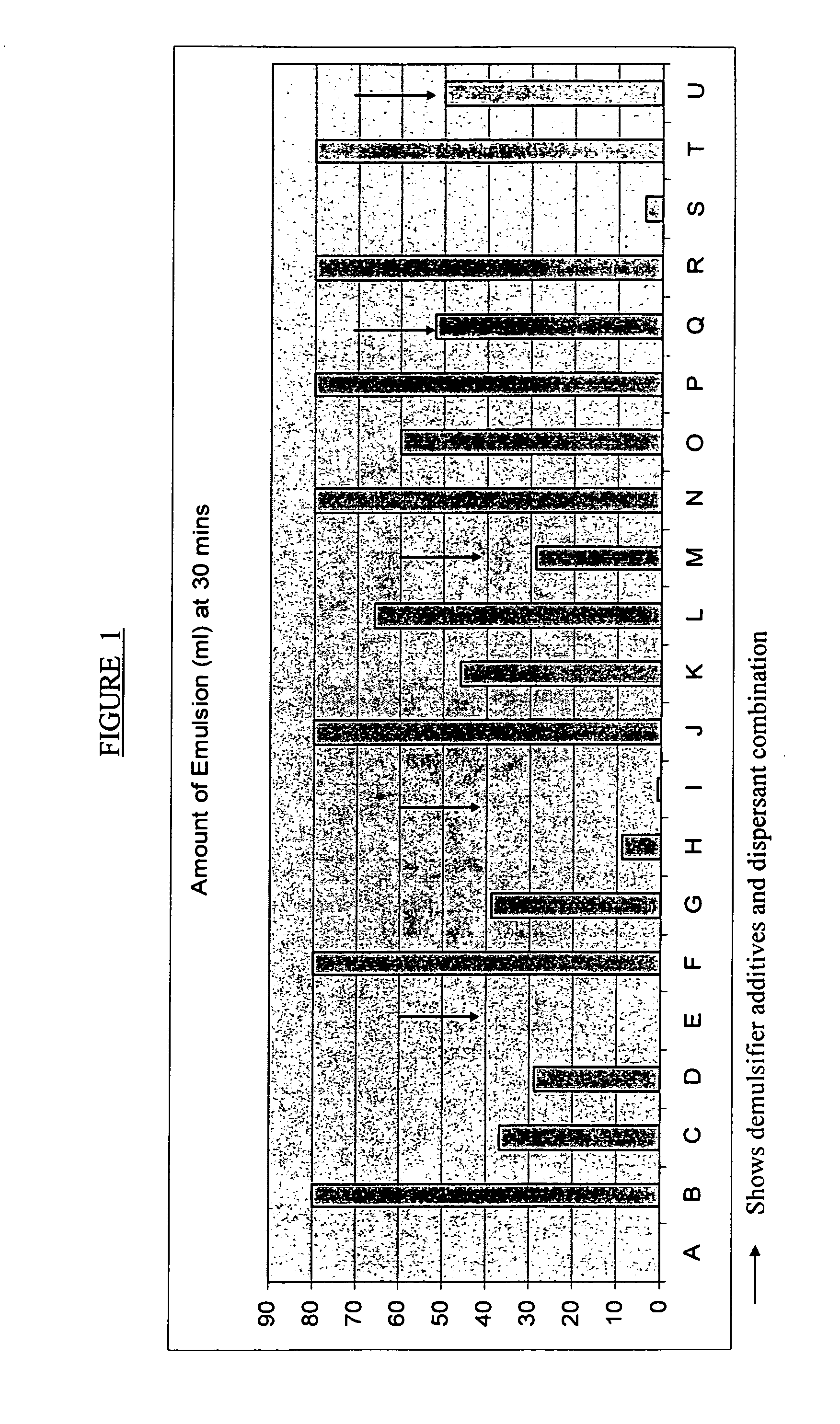Synergistic combination of demulsifiers for enhancing demulsification properties in industrial lubricants
a technology of demulsifier and demulsifier, which is applied in the direction of lubricant composition, other chemical processes, separation processes, etc., can solve the problems of overall reduction in system performance, wear of system components, and undesireable presence of dispersants in lubricants, so as to improve demulsification properties of lubricant compositions and minimize lacquer formation
- Summary
- Abstract
- Description
- Claims
- Application Information
AI Technical Summary
Benefits of technology
Problems solved by technology
Method used
Image
Examples
example 1
[0044]A series of lubricant compositions were formulated and evaluated for their ability to demulsify water.
[0045]Group I 150N is a base stock oil having a kinematic viscosity at 40° C. of 30 cSt and a Viscosity Index of 95 according to ASTM standards D445 and D2270, respectively. Group I 600N is a base stock oil having a kinematic viscosity at 40° C. of 112 cSt and a Viscosity Index of 95 according to ASTM standards D445 and D2270, respectively.
[0046]The untreated polyisobutylene succinimide type dispersant has a molecular weight ranging between about 1,000 and about 3,000.
[0047]The first co-polymer of propylene oxide and ethylene oxide contains —OH end groups. The amount of first co-polymer used is given on an as received basis. The concentration of the first co-polymer in the mixture received from the manufacturer is approximately 44 wt. %. The second co-polymer of propylene oxide and ethylene oxide contains methyl carbonate and methyl ether end caps. The amount of second co-poly...
example 2
[0053]Another series of lubricant compositions were formulated and evaluated for their ability to demulsify oil and water, according to the procedure of Example 1. The formulations and results of this evaluation are provided in Table 2. The dispersant used is an untreated polyisobutylene succinimide type dispersant having a molecular weight ranging between about 1,000 and about 3,000. All other ingredients and test methods were identical to those used in the formulations of Table 1.
TABLE 2FGHIGroup I 150N, wt. %35.0035.0035.0035.00Group I 600N, wt. %64.7064.6864.6864.68Untreated polyisobutylene0.200.200.200.20succinimide type dispersant,wt. %A first co-polymer of0.020.01propylene oxide and ethyleneoxide, wt. %A second co-polymer of0.020.01propylene oxide and ethyleneoxide, wt. %Pour Pt. Depressant, wt. %0.100.100.100.10KV at 40° C. according to69.4469.3269.3369.32ASTM D445Oil / Water / Emulsion (mL)0 / 0 / 8029 / 36 / 1541 / 30 / 941 / 38 / 1(Time, min.)(30)(30)(30)(30)
[0054]As shown in Table 2, the de...
example 3
[0055]Another series of lubricant compositions were formulated and evaluated for their ability to demulsify oil and water according to the procedure of Example 1. In this example, the dispersant used is a zinc blocked succinimide type dispersant. The formulations and results of this evaluation are provided in Table 3.
TABLE 3JKLMGroup I 150N, wt. %35.0035.0035.0035.00Group I 600N, wt. %64.7064.6864.6864.68Zinc-blocked succinimide type0.200.200.200.20dispersant, wt. %A first co-polymer of0.020.01propylene oxide and ethyleneoxide, wt. %A second co-polymer of0.020.01propylene oxide and ethyleneoxide, wt. %Pour Pt. Depressant, wt. %0.100.100.100.10KV at 40° C. according to69.1869.1169.1969.25ASTM D445Oil / Water / Emulsion (mL)0 / 0 / 8029 / 5 / 460 / 14 / 6635 / 18 / 27(Time, min.)(30)(30)(30)(30)
[0056]Not all combinations of dispersants and demulsifier additives function as surprisingly as those disclosed in Table 1 and 2. As can be seen in Trial M, the resulting mixture was not completely demulsified. Af...
PUM
 Login to View More
Login to View More Abstract
Description
Claims
Application Information
 Login to View More
Login to View More - R&D
- Intellectual Property
- Life Sciences
- Materials
- Tech Scout
- Unparalleled Data Quality
- Higher Quality Content
- 60% Fewer Hallucinations
Browse by: Latest US Patents, China's latest patents, Technical Efficacy Thesaurus, Application Domain, Technology Topic, Popular Technical Reports.
© 2025 PatSnap. All rights reserved.Legal|Privacy policy|Modern Slavery Act Transparency Statement|Sitemap|About US| Contact US: help@patsnap.com

